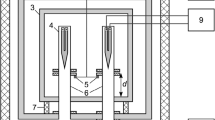In 2021, the State primary standard of the power spectral density unit of noise radio emission in the frequency range of 0.002 to 178.3 GHz GET 21-2021 was approved. Low-temperature noise generators were included in GET 21-2021 as primary standard measures. The designed and manufactured primary standard measures were studied, namely two coaxial low-temperature noise generators in the frequency ranges of 0.002–4.0 GHz and 4.0–12.05 GHz and three waveguide low-temperature noise generators in the frequency ranges of 12.05–17.44 GHz, 17.44–25.86 GHz, and 25.86–37.5 GHz. Equivalent noise temperatures of primary standard measures were investigated and calculated. The reproducible value of the equivalent noise temperature for coaxial low-temperature noise generators was 77.5–84.82 K, and 78.4–80.53 K for waveguide low-temperature noise generators. Comparators, namely noise signal receivers covering five frequency ranges (two coaxial paths: 0.002–4.0 GHz and 4.0–12.05 GHz; three waveguide lines: 12.5–17.44 GHz; 17.44–25.86 GHz, and 25.86–37.5 GHz) were developed and manufactured. The dynamic range of measurements was increased, and the error in transmitting a unit of the power spectral density of noise radio emission was reduced. The total error in reproducing the power spectral density unit of noise radio emission was 0.24–0.30 K, the expanded uncertainty of transferring the power spectral density unit of noise radio emission to secondary standards and working standards of the first echelon was 0.4–0.8 K, and the measurement error of the power spectral density of noise radio emission decreased by a factor of 1.5. The uncertainties in the transfer of a unit of the power spectral density of noise radio emission from primary standard measures to secondary standards and working standards of the first echelon were comparatively analyzed.
The results of this work are applicable in the radio industry for noise parameter measurements. The sensitivity values of instruments and devices whose operation depends on the level of noise electromagnetic oscillations, such as measuring noise generators, are controlled by measures of the power spectral density of noise radio emission.


Similar content being viewed by others
Notes
Order of the Federal Agency for Technical Regulation and Metrology dated February 2, 2021 No. 67 "On approval of the State primary standard of the unit of power spectral density of noise radio emission in the frequency range of 0.002–178.3 GHz".
References
V. I. Aderikhin, Y. A. Burenkov, M. V. Sargsyan, and R. I. Uzdin, Meas. Tech., 55, 1335–1343 (2013), https://doi.org/10.1007/s11018-013-0131-3.
C. T. Stelzried, IEEE Trans. Microw. Theory Tech., September, 16, No. 9, 646–655 (1968), https://doi.org/10.1109/TMTT.1968.1126767.
L. P. Emel'yanova, Meas. Tech., 28, 788–789 (1985), https://doi.org/10.1007/BF00862752.
M. P. Malkov (ed.), Handbook of Physical and Technical Fundamentals of Cryogenics, Energoatomizdat Publ., Moscow, p. 90, 123, 176 (1963).
V. G. Averin, B. A. Aronzon, and N. S. Babaev, Tables of Physical Quantities. Directory, I. K. Kikoina (Ed.), Atomizdat Publ., Moscow (1976).
O. G. Petrosyan, O. S. Abramova, V. A. Gol'ba, T. Ya. Zhdanova, and E. F. Yurchuk, Meas. Tech., 27, 1053–1055 (1984), https://doi.org/10.1007/BF00861834.
O. G. Petrosyan and M. V. Sargsyan, Meas. Tech., 36, 335–337 (1993), https://doi.org/10.1007/BF01003672.
W. Daywitt, "A coaxial noise standard for the 1 GHz to 12.4 GHz frequency range," Technical Note (NIST TN), 1074, National Institute of Standards and Technology, Gaithersburg, MD (1984) (accessed November 11, 2022).
C. Grosvenor, J. Randa, and R. Billinger, "Design and testing of NFRad — a new noise measurement system," Technical Note (NIST TN), 1518, National Institute of Standards and Technology, Gaithersburg, MD (2000) [online], available at: https://tsapps.nist.gov/publication/get_pdf.cfm?pub_id=6264 Accessed: 11/11/2022).
V. A. Slaev, Guidance on the Expression of Measurement Uncertainty [translated from English by V. A. Slaev (Ed.)], St. Petersburg, D. I. Mendeleyev Institute for Metrology Publ. (1999).
J. Randa, E. Gerecht, D. Gu, and R. L. Billinger, IEEE Trans. Microw. Theory Tech., March, 54, No. 3, 1180–1189 (2006), https://doi.org/10.1109/TMTT.2005.864107.
J. Randa and D. K. Walker, IEEE Trans. Instrum. Meas., 56, No. 2, 551–554 (April, 2007), https://doi.org/10.1109/TIM.2007.891145.
J. Randa, 84th ARFTG Microwave Meas. Conf., 1–8 (2014), https://doi.org/10.1109/ARFTG.2014.7013402.
M. M. Rahmati and A. Banai, Int. J. RF Microw. C. E., 31, No. 5, 1–18 (2021), https://doi.org/10.1002/mmce.22599.
Author information
Authors and Affiliations
Corresponding author
Additional information
Translated from Izmeritel'naya Tekhnika, No. 12, pp. 3–9, December, 2022.
Rights and permissions
Springer Nature or its licensor (e.g. a society or other partner) holds exclusive rights to this article under a publishing agreement with the author(s) or other rightsholder(s); author self-archiving of the accepted manuscript version of this article is solely governed by the terms of such publishing agreement and applicable law.
About this article
Cite this article
Aderikhin, V.I., Malay, I.M., Markova, M.S. et al. State Primary Standard of the Power Spectral Density Unit of Noise Radio Emission in the Frequency Range from 0.002 to 178.3 GHz Get 21-2021. Meas Tech 65, 867–875 (2023). https://doi.org/10.1007/s11018-023-02162-4
Received:
Accepted:
Published:
Issue Date:
DOI: https://doi.org/10.1007/s11018-023-02162-4




